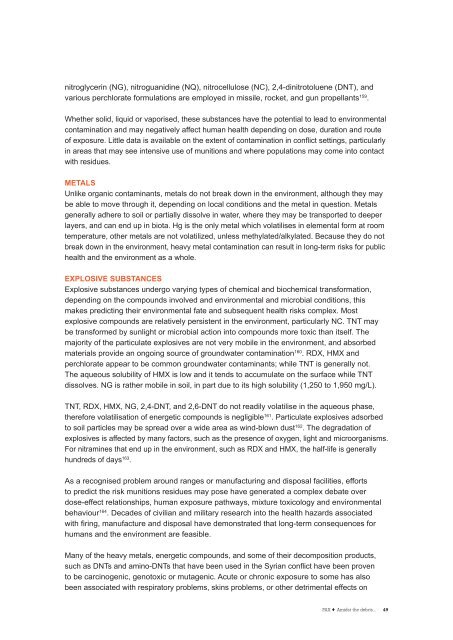Amidst the debris..
pax-report-amidst-the-debris-syria-web
pax-report-amidst-the-debris-syria-web
You also want an ePaper? Increase the reach of your titles
YUMPU automatically turns print PDFs into web optimized ePapers that Google loves.
nitroglycerin (NG), nitroguanidine (NQ), nitrocellulose (NC), 2,4-dinitrotoluene (DNT), and<br />
various perchlorate formulations are employed in missile, rocket, and gun propellants 159 .<br />
Whe<strong>the</strong>r solid, liquid or vaporised, <strong>the</strong>se substances have <strong>the</strong> potential to lead to environmental<br />
contamination and may negatively affect human health depending on dose, duration and route<br />
of exposure. Little data is available on <strong>the</strong> extent of contamination in conflict settings, particularly<br />
in areas that may see intensive use of munitions and where populations may come into contact<br />
with residues.<br />
METALS<br />
Unlike organic contaminants, metals do not break down in <strong>the</strong> environment, although <strong>the</strong>y may<br />
be able to move through it, depending on local conditions and <strong>the</strong> metal in question. Metals<br />
generally adhere to soil or partially dissolve in water, where <strong>the</strong>y may be transported to deeper<br />
layers, and can end up in biota. Hg is <strong>the</strong> only metal which volatilises in elemental form at room<br />
temperature, o<strong>the</strong>r metals are not volatilized, unless methylated/alkylated. Because <strong>the</strong>y do not<br />
break down in <strong>the</strong> environment, heavy metal contamination can result in long-term risks for public<br />
health and <strong>the</strong> environment as a whole.<br />
EXPLOSIVE SUBSTANCES<br />
Explosive substances undergo varying types of chemical and biochemical transformation,<br />
depending on <strong>the</strong> compounds involved and environmental and microbial conditions, this<br />
makes predicting <strong>the</strong>ir environmental fate and subsequent health risks complex. Most<br />
explosive compounds are relatively persistent in <strong>the</strong> environment, particularly NC. TNT may<br />
be transformed by sunlight or microbial action into compounds more toxic than itself. The<br />
majority of <strong>the</strong> particulate explosives are not very mobile in <strong>the</strong> environment, and absorbed<br />
materials provide an ongoing source of groundwater contamination 160 . RDX, HMX and<br />
perchlorate appear to be common groundwater contaminants; while TNT is generally not.<br />
The aqueous solubility of HMX is low and it tends to accumulate on <strong>the</strong> surface while TNT<br />
dissolves. NG is ra<strong>the</strong>r mobile in soil, in part due to its high solubility (1,250 to 1,950 mg/L).<br />
TNT, RDX, HMX, NG, 2,4-DNT, and 2,6-DNT do not readily volatilise in <strong>the</strong> aqueous phase,<br />
<strong>the</strong>refore volatilisation of energetic compounds is negligible 161 . Particulate explosives adsorbed<br />
to soil particles may be spread over a wide area as wind-blown dust 162 . The degradation of<br />
explosives is affected by many factors, such as <strong>the</strong> presence of oxygen, light and microorganisms.<br />
For nitramines that end up in <strong>the</strong> environment, such as RDX and HMX, <strong>the</strong> half-life is generally<br />
hundreds of days 163 .<br />
As a recognised problem around ranges or manufacturing and disposal facilities, efforts<br />
to predict <strong>the</strong> risk munitions residues may pose have generated a complex debate over<br />
dose-effect relationships, human exposure pathways, mixture toxicology and environmental<br />
behaviour 164 . Decades of civilian and military research into <strong>the</strong> health hazards associated<br />
with firing, manufacture and disposal have demonstrated that long-term consequences for<br />
humans and <strong>the</strong> environment are feasible.<br />
Many of <strong>the</strong> heavy metals, energetic compounds, and some of <strong>the</strong>ir decomposition products,<br />
such as DNTs and amino-DNTs that have been used in <strong>the</strong> Syrian conflict have been proven<br />
to be carcinogenic, genotoxic or mutagenic. Acute or chronic exposure to some has also<br />
been associated with respiratory problems, skins problems, or o<strong>the</strong>r detrimental effects on<br />
PAX ! <strong>Amidst</strong> <strong>the</strong> <strong>debris</strong>...<br />
49


